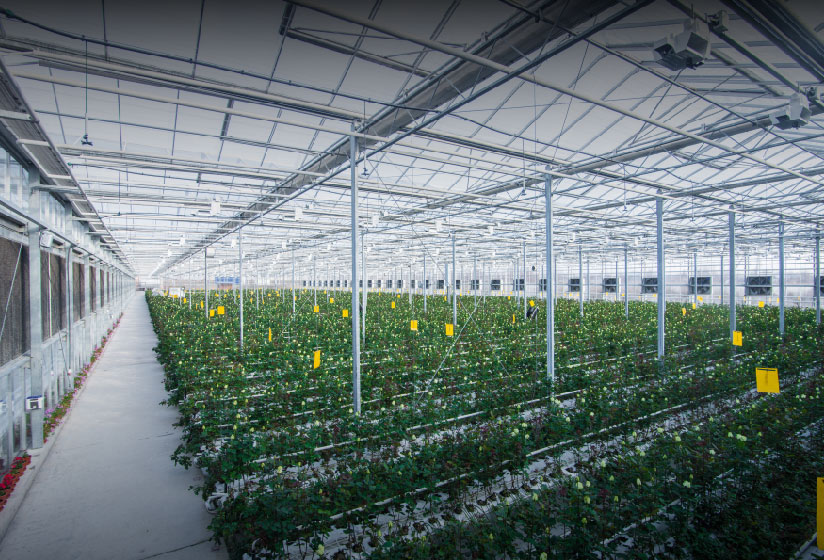Growth and Innovation in the Commercial Greenhouse Market: Driving Sustainable and Efficient Food Production
Agriculture and Agri Inputs | 02-Jan-2025


The commercial greenhouse market is experiencing significant growth as demand for sustainable agricultural practices, increased food production, and climate-controlled environments rises. Greenhouses allow for year-round crop cultivation by providing an environment that can be carefully controlled to optimize plant growth, regardless of external weather conditions. This technology-driven sector is pivotal in addressing global food security, urbanization, and sustainability concerns. As urban populations continue to grow, the need for locally grown food with reduced transportation footprints has propelled the adoption of commercial greenhouses across the globe.
Commercial greenhouses are utilized in a variety of sectors, including vegetable, flower, and fruit production. They enable farmers to extend growing seasons, enhance crop yields, and reduce dependency on traditional farming methods. Vegetables such as tomatoes, cucumbers, and leafy greens are often grown in controlled greenhouse environments, ensuring a constant supply to meet consumer demand. Flowers, herbs, and other ornamental plants also benefit from the ability to grow in a controlled environment, providing high-quality products year-round. With the increasing global preference for organic produce, greenhouses are becoming essential for growing pesticide-free and high-quality crops, meeting consumer demands for cleaner and healthier food.
Technological advancements in greenhouse design, automation, and climate control systems are driving growth in the commercial greenhouse market. The integration of advanced technologies such as LED lighting, hydroponics, and precision irrigation is enabling more efficient use of resources and enhancing plant growth. LED lighting systems provide specific light spectrums tailored to plant needs, improving energy efficiency while promoting faster growth. Hydroponic systems allow crops to grow without soil, reducing water usage and increasing crop yields. Moreover, precision irrigation systems ensure that plants receive the right amount of water at the right time, minimizing water waste and ensuring optimal crop performance.
The adoption of smart greenhouse technologies is another key factor contributing to market growth. With the help of IoT sensors and advanced analytics, commercial greenhouses can monitor and control environmental factors such as temperature, humidity, soil moisture, and CO2 levels in real time. This data-driven approach allows growers to optimize conditions for plant growth, reduce energy consumption, and minimize waste. Automated systems such as robotic harvesters and drones are further improving efficiency in greenhouses, enabling faster harvests and reducing labor costs. The integration of AI and machine learning algorithms helps predict crop performance and optimize cultivation strategies, enhancing both productivity and sustainability.
The commercial greenhouse market is also benefiting from a shift toward sustainability and environmental responsibility. Traditional farming practices often contribute to soil degradation, water scarcity, and high carbon footprints. In contrast, commercial greenhouses can significantly reduce resource consumption. By utilizing controlled environments, greenhouses can minimize water waste, reduce pesticide use, and lower transportation-related carbon emissions, making them an environmentally friendly option for food production. Additionally, the use of renewable energy sources such as solar panels and wind turbines is gaining traction in greenhouse operations, further reducing their environmental impact and making them more energy-efficient.
Regional factors also play an important role in shaping the commercial greenhouse market. In North America and Europe, there is a growing focus on local food production to reduce the reliance on imported goods. The adoption of greenhouses in urban settings, including rooftop greenhouses and vertical farming, is growing in these regions. These solutions not only support sustainable food production but also help address the issue of limited agricultural land in densely populated areas. In Asia-Pacific, the market is being driven by rising urbanization, increased demand for high-value crops, and the adoption of modern farming techniques. Countries like Japan, China, and South Korea are investing heavily in greenhouse technology to meet domestic food needs and reduce dependency on food imports.
Furthermore, government initiatives and subsidies are boosting the growth of the commercial greenhouse market. Many governments are promoting greenhouse farming as part of their broader sustainability and food security strategies. Financial support, tax incentives, and policy frameworks aimed at encouraging the development of eco-friendly agricultural technologies are helping to increase greenhouse adoption. In some regions, commercial greenhouse farming is even being incorporated into urban planning projects to promote local, sustainable food sources.
The market for commercial greenhouses is also evolving in response to consumer demand for organic and specialty crops. With the increasing popularity of organic food, commercial greenhouses offer an ideal environment for pesticide-free cultivation. Additionally, the demand for high-quality, locally grown flowers and ornamental plants has led to the expansion of greenhouse operations in the floral industry. The versatility of greenhouses enables farmers to diversify crop production and tap into niche markets, further boosting the market’s potential.
Looking ahead, the commercial greenhouse market is poised for continued growth, driven by advancements in technology, sustainability initiatives, and increasing food demand. With the growing need for sustainable farming practices, coupled with the rising adoption of smart technologies, the market is likely to see significant innovation and expansion. As commercial greenhouses become an integral part of the global food production system, they will play a critical role in ensuring a more sustainable and secure food future.
In conclusion, the commercial greenhouse market is rapidly growing as a result of technological innovation, environmental sustainability, and increasing demand for high-quality, locally produced food. The adoption of smart, efficient, and sustainable greenhouse technologies is revolutionizing agriculture, helping to meet the challenges of food security, climate change, and resource management. As the market continues to expand, commercial greenhouses will increasingly become a cornerstone of modern farming, offering sustainable solutions to feed the world’s growing population.




